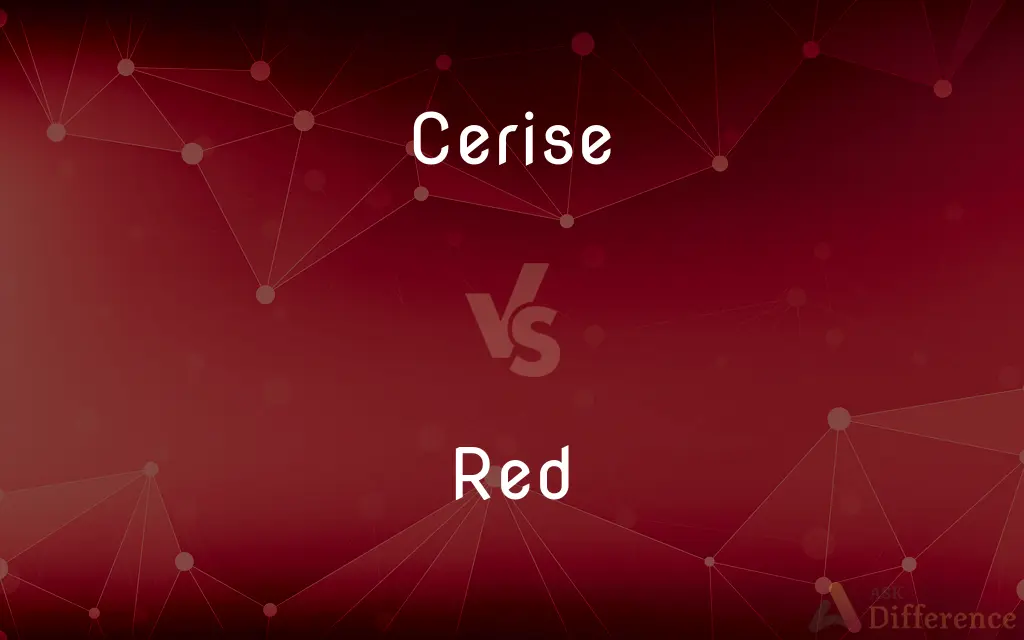Cerise vs. Red — What's the Difference?
Edited by Tayyaba Rehman — By Urooj Arif — Updated on March 27, 2024
Cerise is a deep, vivid red color with a pinkish hue, while red is a primary color that ranges broadly in shade from light to dark.

Difference Between Cerise and Red
Table of Contents
ADVERTISEMENT
Key Differences
Cerise is a specific shade of red that leans slightly towards pink, offering a rich, deep color often associated with cherries. In contrast, red is a primary color, foundational in the color spectrum, and can vary widely in shade from bright and light to dark and burgundy.
Red serves as a primary color in both the RGB (Red, Green, Blue) and RYB (Red, Yellow, Blue) color systems, making it fundamental in art, design, and color theory. Cerise, on the other hand, is considered a tertiary color, derived from a mixture of primary and secondary colors, specifically red with a touch of purple or pink.
While red is often associated with strong emotions such as love, passion, and anger, cerise evokes a sense of playful sophistication and is frequently used in fashion and design to convey a unique, stylish flair.
In terms of use, red is versatile, appearing in everything from warning signs to national flags, symbolizing a wide range of concepts and emotions. Cerise, with its specific hue, is more commonly used in decorative contexts, fashion, and to create thematic visual statements.
Both colors have cultural and symbolic meanings, but red's significance is broader and more universally recognized due to its primacy and prevalence in nature and human-made symbols. Cerise, while distinct and recognizable, carries a narrower range of associations, often tied to specific contexts or aesthetic preferences.
ADVERTISEMENT
Comparison Chart
Shade
Deep, vivid red with a pinkish hue
Broad range from light to dark
Color System
Tertiary color
Primary color
Associations
Playful sophistication, fashion
Love, passion, anger, danger
Use
Fashion, design, decorative contexts
Versatile, wide-ranging applications
Symbolism
Unique, stylish
Broad and universally recognized meanings
Compare with Definitions
Cerise
A deep red color with a pinkish hue, resembling cherry.
The dress was a striking shade of cerise.
Red
A primary color at the lower wavelengths of visible light.
The red balloon stood out against the blue sky.
Cerise
Used in fashion to denote a rich, vibrant red tone.
Her cerise scarf added a pop of color to her outfit.
Red
Ranges from bright shades to deep burgundy.
She preferred a dark red wine.
Cerise
Symbolic of playful sophistication.
The cerise highlights in the décor gave the room a chic look.
Red
Symbolic of strong emotions like love and anger.
Red roses are often given as a sign of love.
Cerise
A tertiary color that adds a unique flair.
The artist used cerise to bring warmth and depth to the painting.
Red
Foundational in color theory and art.
Mixing red and blue paint creates purple.
Cerise
Often associated with cherries and berry tones.
The cerise lipstick was perfect for a summer evening.
Red
Versatile in use, from warning signs to fashion.
The red stop sign is universally recognized.
Cerise
A deep to vivid purplish red.
Red
Red is the color at the long wavelength end of the visible spectrum of light, next to orange and opposite violet. It has a dominant wavelength of approximately 625–740 nanometres.
Cerise
A deep, bright red colour tinted with pink.
Red
A pigment or dye having a red hue.
Cerise
(of textiles, especially silk) Cherry-colored; a light bright red.
Red
Something that has a red hue.
Cerise
Cherry-colored; a light bright red; - applied to textile fabrics, especially silk.
Red
Often Red A Communist.
Cerise
A red the color of ripe cherries
Red
A revolutionary activist.
Red
The condition of being in debt or operating at a loss
The firm has been in the red all year.
Red
Reddish in color or having parts that are reddish in color
A red dog.
A red oak.
Red
Having a reddish or coppery skin color.
Red
Often Red Often Offensive Of or being a Native American.
Red
Having a ruddy or flushed complexion
Red with embarrassment.
Red
Relating to or being a red state.
Red
Often Red Communist.
Red
Having red#Noun as its color.
The girl wore a red skirt.
Red
(of hair) Having an orange-brown or orange-blond colour; ginger.
Her hair had red highlights.
Red
(of the skin) With a red hue due to embarrassment or sunburn.
Red
Of the hearts or diamonds suits. Compare of the spades or clubs suits
I got two red queens, and he got one of the black queens.
Red
Supportive of, related to, or dominated by a political party or movement represented by the color red:
Red
Left-wing parties and movements, chiefly socialist or communist, including the U.K. Labour party and the Social Democratic Party of Germany.
The red-black grand coalition in Germany
Red
(US politics) The U.S. Republican Party.
A red state
A red Congress
Red
Amerind; relating to Amerindians or First Nations
Red
(astronomy) Of the lower-frequency region of the (typically visible) part of the electromagnetic spectrum which is relevant in the specific observation.
Red
(particle physics) Having a color charge of red.
Red
(countable) A revolutionary socialist or (most commonly) a Communist; usually capitalized a Bolshevik, a supporter of the Bolsheviks in the Russian Civil War.
Red
One of the 15 red balls used in snooker, distinguished from the colours.
Red
Red wine.
Red
(countable) Any of several varieties of ale which are brewed with red or kilned malt, giving the beer a red colour.
Red
A red kangaroo.
Red
A redshank.
Red
An American Indian.
Red
(slang) The drug secobarbital; a capsule of this drug.
Red
(informal) A red light a traffic signal
Red
(particle physics) One of the three color charges for quarks.
Red
Usually in the phrase "bowl of red".
Red
(informal) The redfish or red drum, Sciaenops ocellatus, a fish with reddish fins and scales.
Red
Tomato ketchup.
Red
(archaic) rede
Red
To put on order; to make tidy; also, to free from entanglement or embarrassement; - generally with up; as, to red up a house.
Red
A red pigment.
Red
The menses.
Red
A tributary of the Mississippi River that flows eastward from Texas along the southern boundary of Oklahoma and through Louisiana
Red
Emotionally charged terms used to refer to extreme radicals or revolutionaries
Red
The amount by which the cost of a business exceeds its revenue;
The company operated at a loss last year
The company operated in the red last year
Common Curiosities
How is cerise perceived in fashion compared to red?
Cerise is seen as a bold, fashionable choice, adding a unique touch, whereas red is classic and versatile.
What distinguishes cerise from red?
Cerise is a specific shade of red with a pinkish hue, while red is a primary color with a broader range of shades.
Is cerise more modern than red?
Cerise may be considered more contemporary in specific contexts, like fashion, due to its stylish and unique hue.
What emotions does cerise evoke?
Cerise evokes feelings of joy, playfulness, and a sense of fashionable sophistication.
Can cerise be used in place of red?
Depending on the context, cerise can substitute for red if a deeper, pink-toned red is desired.
Are there emotional differences in the use of cerise vs. red?
Red is often associated with intense emotions and signals, while cerise is linked to style and sophistication.
Can the meaning of cerise and red vary culturally?
Yes, both colors can have varying symbolic meanings across different cultures, though red's meanings are more universally recognized.
Is cerise considered a type of red?
Yes, cerise is considered a type of red but with specific characteristics that set it apart.
How do artists use cerise in their work compared to red?
Artists use cerise to add depth, warmth, and a touch of playful brightness, while red is used for its impact and versatility.
What industries use cerise prominently?
The fashion and design industries use cerise prominently for its vibrant, stylish appeal.
Why is red considered a primary color and cerise not?
Red is a primary color because it cannot be created by mixing other colors, while cerise is derived from mixing red with other hues.
Can both cerise and red be found in nature?
Yes, both colors are present in nature, in flowers, fruits, and landscapes, though red is more prevalent.
How do the physical properties of cerise and red differ?
The main difference lies in their hue; cerise has a pinkish tone, while red encompasses a wider range of wavelengths on the visible spectrum.
Are there any historical contexts where cerise played a significant role?
Cerise has been noted in fashion and art history for its bold and distinctive appearance, though specific historical contexts vary.
How do the symbolic meanings of cerise and red influence their use in branding?
Red is used in branding for its attention-grabbing and emotionally evocative power, while cerise might be chosen for a unique, stylish, and playful image.
Share Your Discovery

Previous Comparison
Lest vs. Least
Next Comparison
Hot vs. SpicyAuthor Spotlight
Written by
Urooj ArifUrooj is a skilled content writer at Ask Difference, known for her exceptional ability to simplify complex topics into engaging and informative content. With a passion for research and a flair for clear, concise writing, she consistently delivers articles that resonate with our diverse audience.
Edited by
Tayyaba RehmanTayyaba Rehman is a distinguished writer, currently serving as a primary contributor to askdifference.com. As a researcher in semantics and etymology, Tayyaba's passion for the complexity of languages and their distinctions has found a perfect home on the platform. Tayyaba delves into the intricacies of language, distinguishing between commonly confused words and phrases, thereby providing clarity for readers worldwide.














































